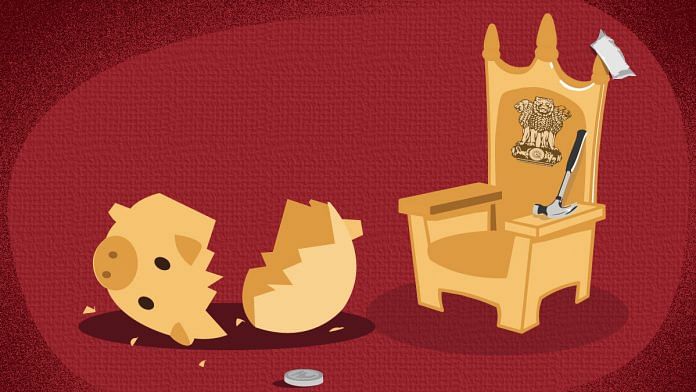The tax revenue numbers published in Business Standard Thursday are a shock. They show a shortfall of Rs 1.6 lakh crore, when compared to the revised revenue numbers for 2018-19 presented to Parliament three months ago. That represents over 0.8 per cent of gross domestic product (GDP). Some of the shortfall would have been compensated by a last-minute squeeze on expenditure, reported at the year-end to have been about Rs 60,000 crore. Taking that as accurate, the fiscal deficit numbers for the year would have gone up from the reported 3.4 per cent of GDP to about 3.9 per cent — clear slippage from the levels of the last two years.
The numbers are a shock for a further reason: The Centre’s revenue growth clocks in at only about 6.2 per cent. It is understandable if this falls short of the ambitiously budgeted revenue growth of 19.5 per cent. What is more worrying is that growth in gross collection (including the states’ share), at 8.4 per cent, falls short of GDP growth (in nominal terms, i.e. including inflation) of 11.5 per cent. In other words, the trend of an increasing tax-GDP ratio has been reversed. Some of the shortfall may have been on account of the progressive cutting of rates for the goods and services tax. But there is the possibility that real economic growth (ie adjusted for inflation) may be less than the officially reported 7 per cent.
The implications for the current year are grim. The Budget numbers for 2019-20 project revenue growth of 14.9 per cent on the numbers that had been expected for 2018-19. On the real revenue base that has emerged, tax collection would have to grow 29.1 per cent in order to meet the new year’s Budget numbers. Since that is impossible, the Budget will have to be substantially re-cast as soon as a new government takes charge after the elections. Both revenue and expenditure numbers will have to be trimmed — and then may better reflect the deceleration of economic activity caused by slowing consumption trends. Since much of government expenditure is on pre-committed items like interest payments, subsidies, salaries and pensions, the axe will fall (as it did late last year) on investment in the physical infrastructure, an important driver of growth so far.
Also read: Questions on economy can wait, it’s enough that Congress has promised so many freedoms
In terms of the growth outlook, some factors have improved — like the global economic situation, and receding prospects of a US-China trade war. Oil prices have climbed, but various oil exporters may up output to neutralise the stoppage of supplies from Iran. Domestically, the monsoon prospects are less than optimal, while two lead sectors (aviation and automobiles) have taken a toss and a third (telecom) has seen value destruction, even as construction remains dependent on government spending. The financial and corporate sectors have come through the worst of the twin crises of bad loans and excessive debt, and credit has picked up. But much cleaning up remains to be done, and further systemic shocks cannot be ruled out. Monetary policy has tried to support growth, but the Reserve Bank’s rate cuts find no echo in a liquidity-constrained market for a variety of reasons, including the level of government borrowing. Real interest rates remain high.
This is a sobering context in which to consider the promises of expansive hand-outs as part of the election campaign: Loan write-offs, cash payouts, and possibly a higher food subsidy. As should be obvious, there simply isn’t the fiscal space for all of this, or indeed any of it. When the limits of monetary policy are being tested, the fisc has to be in contractionary mode — especially since the official deficit numbers conceal off-balance sheet borrowing. As it is, the ratio of government debt to GDP remains above the limits reckoned to be desirable.
The danger is a post-poll government being tempted to go the other way, taking comfort from moderate inflation and opting for expansionist policies in order to deliver on unaffordable election promises or in pursuit of unrealisable growth objectives — precisely the kind of policy heresy being heard currently in some other countries.
By Special Arrangement with Business Standard
Also read: India will face a fiscal crisis if BJP or Congress fulfil their election promises







On a lighter note, anyone would love to take a cold shower in Delhi in late May. To get a sense of what awaits the new economic team, think instead of Akshay Kumar’s native Toronto in winter.
Very disappointed that that Dr Singh, Shri Chidambaram, Dr Rajan ( somewhat cryptically )are supporting NYAY, compounding the error by claiming that no new taxes – on the long suffering middle class – will be required, growth will pick up the tab. Before any newly elected government readies a shower of largesse, the economic team will have to peel away the fudge and the artifice, lay bare the true figures on the economy. Expect a few calls from the rating agencies as well. Try to recall the last warmly complimentary article that appeared in credible western media on either the “ India story “ or the direction the country is headed in. Not meant to sound alarmist but if growth does not pick up meaningfully, expect agitations and social disturbances, a teaser of which appeared in the form of agitations by dominant castes in some states, seeking the benefit of reservations.